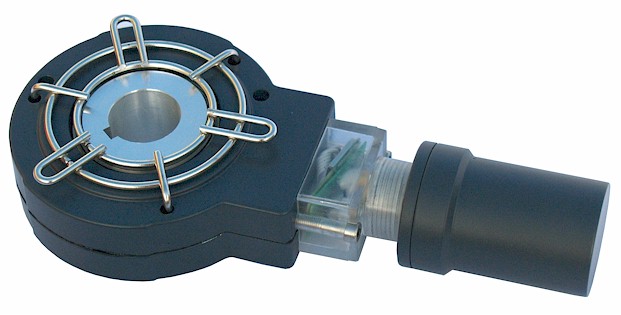|
Introduction
The Hohner Wireless system consists
of a battery pack, a transmitter, the encoder and the receiver
module. The transmitter is built onto the encoder and the
battery pack can be replaced in the 'hot' zone by anyone.
The photo below shows in detail the components.
Pretty
much, the power is 'wireless' and intrinsically safe,
unlike current systems on the market where you still
have to power the system with wires...which defeats the
whole purpose...or if they are battery powered, the
battery is way to big and cumbersome, and zone 1
certified only instead of zone 0, and can NOT be
hot-swapped.
The battery pack and encoder
and transmitter are all certified to Ex ia IIC
standards.
IECEX (IECEx SIR 08-0015X) certificate
ATEX (SIRA 08ATEX2054X) certificate
Data Transmission
Encoder to Receiver is 2.4 GHz.
Proprietary data transmission.
Data rate is 250 kbs
Peak RF output is 0dBm,
about 1mW
Receiver to Controller
output is Hardware:
RS232, Quadrature or 4...20 mA
Possible protocols can be ASCII,
ModBus, ProfiBus, DeviceNet
Data Output Speed per Type
of Sensors
Incremental Encoder:
Data packet (set of pulses) every 16ms
Absolute Encoder: 1
position every 20 seconds
Multiturn Encoder: 1
position every 60 seconds
Fuel sensor: 1 reading
every 60 seconds
These speeds and formats are
for about 5 year battery life for 24/7 use, and will be standard.
If data has to be read more frequently and quicker, the
battery life will go down accordingly. It is very
easy for us to do, just a couple of lines in C++, so do
not hesitate to ask.
Data Security
Secure data transmission -
signal is checked 3 times
1. Receiver recognizes
only this signal with a product specific code
2. Data is transmitted
with a checksum and verified in the receiver
3. 2.4 GHZ base
frequency is product specific and has 1 MHz
bandwidth in 124 possible channels
A wrong data transmission is not possible. A
data transmission can be missed - this has the
effect that updating is delayed since the
un-transmitted data is stored within the transmitter
until a succesful transmission has occurred, which in
turn sends current data plus the back log of data.
If the sensor loses power or
there is a fault with the sensor, our electronics will
detect this since we allow a maximum time out period of
5 minutes up to an hour (depending on the sensor used
and application) along with the receiver module sending
a signal (ping) to the sensors to check it's status.
Battery Details
We use a lithium thyonide
battery with 19,000 mA hours. Life time is
dependant on the application and number of transmissions
per second, though about 5 years is average for 24/7
use. Another way to determine this is the
theoretical 1 billion data transmissions possible.
We have a long term test
going on in house, at a rate of 30 transmissions per
second and the device has been functioning since August
2011, that comes out to 1 billion data transmissions!
Which means, that so far, the battery lasts longer than
the theory.

|